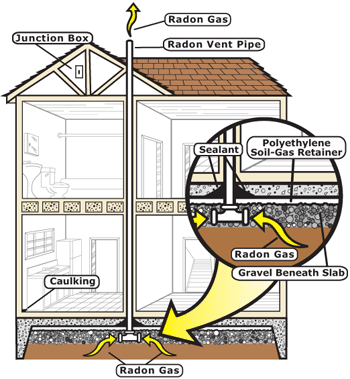
People often ask, “What is radon, and do I need to be concerned about it?”
Let’s address this as two questions. First, radon is an invisible, odorless, and tasteless gas produced by the natural decay of uranium in soil and water. Nationwide, radon gas is the second leading cause of lung cancer after cigarette smoking. Speaking of cigarettes, statistics show that smokers are 10 times more likely to die of cancer when radon is present in the home.
The US Environmental Protection Agency (EPA) reports the national average radon level is 1.3pCi/L (picocuries per liter of air). In 2012 the State of North Carolina reported that several counties in WNC had radon levels higher than the national average, including Buncombe 3.2 pCi/L, Swain 5.3, Jackson 3, Graham 5.5, Cherokee 5.5 and Macon 2.5. Readings vary across the region, and the radon level in your home can vary greatly from your next door neighbors.
Now for the second half of the question, “Do I need to be concerned about it?” The easy answer is yes. The EPA recommends that all homes be tested for radon and mitigated if the radon concentration is 4 picocuries per liter (pCi/L) or higher.
Click here to learn more about radon and your health from the Centers for Disease Control (CDC).
So, how can you find out your home’s radon levels, and what should you do about it if your levels are too high? Let’s take a look.

Testing 1-2-3
Get your home tested for radon. Call Asheville Home Inspector Peter Young, (828) 808-4980, to arrange a test.
Although the EPA recommends taking action if your home tests at 4.0 picocuries per liter (pCi/L) or above, the World Health Organization recommends a more cautious action level of 2.7 pCi/L.
Mitigating circumstances
If your test reveals a high level of radon in your home, you’ll need to enlist the services of a professional radon mitigation company. The average cost of radon mitigation is around $1,500, however costs can vary from $1,000 to about $2,500, depending on specific circumstances.
The mitigation specialists will install a device to remove radon from your home.
Here’s a link about how radon mitigation works from the State of North Carolina.

How to find a reputable company
Since high radon levels are found throughout Western North Carolina, there are a host of companies waiting for your call. They’re not all created equal. Since North Carolina has no licensing requirements for radon mitigation, it’s prudent to practice caveat emptor (let the buyer beware). Here are some criteria you can use to find a good company:
- A good reputation. Customer reviews are a good place to start. Check on Google, Angi (formerly Angie’s List), the Better Business Bureau, and social media. Avoid companies with poor reviews or no reviews.
- Experience. Look for a company that’s been in business for years, rather than months. Experienced companies are likely to do a better job with placement of your radon mitigation system.
- Certification and insurance. In addition to experience, look for a company with certification and insurance. The American Association of Radon Scientists and Technologists (AARST), a nonprofit, trade organization dedicated to the highest standards of excellence and the ethical performance of radon measurement, radon mitigation and knowledge transfer, offers certification for radon companies through the National Radon Proficiency Program. Additionally, certification paves the way for radon contractors to qualify for insurance.
- Warranty protection. Ensure that your investment in radon mitigation is backed by a reliable warranty. Ask your radon professional what type of equipment they use and get details of their written warranty.
- Fair price. There aren’t any one-size-fits all systems for every home, so prices may vary, depending on the type of home, type of system, and type of fan. Prices tend to be competitive company to company, so be cautious about prices that are too high or too low. Some companies will lowball the initial price and then start throwing in add-ons once installation has begun. Be sure to get a reliable quote for your project from your radon professional.

System installation
When you find the right company and iron out all the details, it’s time for installation of the system. There are three factors a reputable company will consider: Aesthetics, effectiveness, and EPA/AARST/NRPP standards.
Be sure to ask your technician to show you multiple location/install options. For example, if you have an unfinished basement that shares a common wall with a garage, the system can be vented through the garage to the roof, rather than through one of the home’s exterior walls.
Retesting
Radon mitigation is not “set and forget.” Once the system is installed and retested you can breathe easily for a while. However, the EPA suggests retesting the home every two years to be sure the system is still performing as intended.
Radon and new contruction
If you are planning new construction, ask your contractor about radon-resistant features. Some examples are gravel and plastic sheeting under the foundation, proper sealing of cracks, and the installation of a vent pipe. After your home is built with these features, don’t skip radon testing before moving in. If levels are elevated, have a radon fan installed. Click here for information from the EPA about radon-resistant features for new construction.
In conclusion, discovering high radon levels in your home is not the end of the world. With proper testing and mitigation, the air quality in your home can be brought back to safe radon levels.
Buying or selling a home in Western North Carolina?
Avoid unpleasant surprises! Contact Asheville Home Inspector Peter Young before signing any contracts. Call (828) 808-4980, or click here to make an appointment.